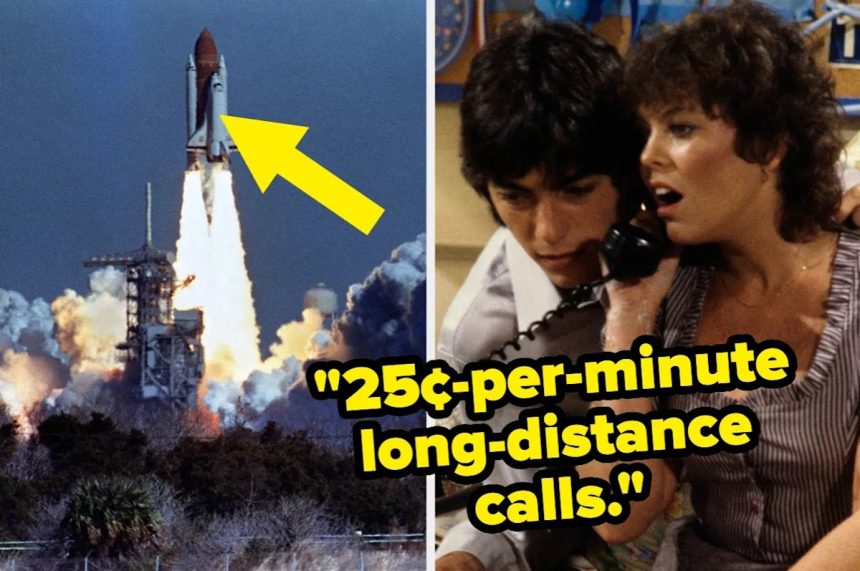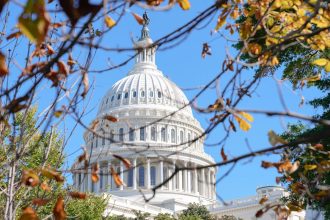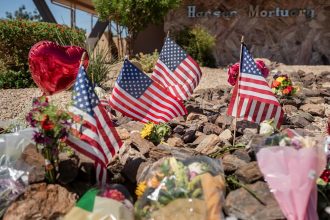The ’80s were neon, noisy, and nuts — a decade of MTV, mixtapes, and mall culture. But underneath all that Aqua Net hairspray and optimism was a whole lot of chaos, tragedy, and straight-up weirdness people rarely talk about anymore. So when Reddit user u/TONTTONCLUB asked, “What are some awful things from the ’80s everyone seems to not talk about?” the answers turned into a time capsule of everything dark, absurd, and unforgettable about the decade that defined a generation:
1. “25¢-per-minute long-distance phone calls.”
Abc Photo Archives / Getty Images
—u/[deleted]“This was in the ’90s, but my mom would wait until after 11 p.m. to call my dad since long-distance calls were so expensive. He was in the Army and would lurk around the phone booth in the tiny village they were stationed at, waiting for her to call and ask for him.”
Here’s the context: In the 1980s, making a long-distance call — a call across state lines or internationally — was an expensive luxury. Prices often hovered around 25 cents a minute (the equivalent of around 75¢ today). Families often timed their calls for “off-peak hours” or weekends when rates dropped, and families abroad severely rationed their conversations to once a week. The entire system began to change only in the early 1990s when new competition from companies like MCI forced AT&T to offer cheaper rates.
Why it mattered (and why we forgot): This high cost meant that personal communication was expensive, deliberate, and often rationed, fundamentally shaping how people maintained relationships over geographic distance. The rapid move to unlimited cellphone plans and then to free global communication services like FaceTime and texting has completely obscured this reality, causing the modern generation to forget how much distance used to cost in a very real, measurable way.
2. “The Challenger explosion. I was in sixth grade. We were going to get to watch transmissions from a school teacher in space. Space missions had gotten to the point of seeming safe and routine. Then, in a split second, seven people died horrifically as we watched on our screens.”

Bob Pearson / Getty Images
Here’s the context: Millions watched live as the Space Shuttle Challenger launched with Christa McAuliffe, a teacher set to become the first ordinary citizen in space. Just 73 seconds after liftoff, the shuttle broke apart in a horrific explosion, killing all seven astronauts on board as millions, including countless schoolchildren, watched live. A subsequent investigation found that engineers had repeatedly warned NASA about faulty O-rings — seals that failed in the cold weather — but managers chose to launch anyway due to schedule pressure.
Why it mattered (and why we forgot): It was a defining national trauma and a devastating example of bureaucratic failure. For many schoolchildren, it was their first confrontation with mortality and institutional negligence. Today, it’s often reduced to a clip without context for the human loss behind it.
3. “The time in 1982 when some guy tampered with Tylenol capsules with cyanide, killing people. The event spawned copycats, which killed even more people.”

Bettmann / Getty Images
Here’s the context: Seven people in the Chicago area died after taking Tylenol capsules laced with cyanide. Panic spread nationwide as people feared their own medicine cabinets. In response, Johnson & Johnson recalled 31 million bottles, losing about $100 million in 1982 dollars, and introduced tamper-proof seals — foil tops, glued boxes, and plastic wrap — that became the global safety standard. The killer was never caught.
Why it mattered (and why we forgot): This incident completely and permanently changed product packaging safety globally, creating a new standard of corporate responsibility and consumer protection. We now open sealed plastic tops and peel foil covers every day, rarely realizing that those seals exist as a direct, physical legacy of a terrifying and unsolved mass murder spree that occurred over 40 years ago. It remains a watershed moment in both criminology and corporate crisis management.
4. “AIDS/HIV. Nobody knew what it was, if it would be curable, how it spread, or if it would spread to the general population. It was damn near like Ebola, but it was right here. Religious fundamentalists were claiming it was God’s wrath visited on homosexuals. Front-page pictures showed victims suffering from Kaposi’s sarcoma. It was pretty terrifying — not least because it brought out the worst in so many people. I lost a couple of friends.”

Thomas Mcgovern / Getty Images
Here’s the context: In 1981, clusters of a mysterious illness appeared among gay men in New York and San Francisco. The government ignored it, the press mocked it, and hospitals often turned patients away out of fear and ignorance. Religious fundamentalists called it “God’s wrath.” By the end of the decade, over 100,000 Americans were dead due to the AIDS epidemic. It took radical activism — especially by ACT UP — to force the FDA to fast-track lifesaving treatments.
Why it mattered (and why we forgot): The AIDS epidemic transformed medicine, activism, and queer rights. It changed how drug trials work and how protest movements target policy. Antiretroviral therapy eventually made HIV manageable, but that progress often obscures the terror, stigma, and neglect that defined its early years.
5. “The ‘Satanic Panic’ — moral outrage over supposed Satanic rituals taking place in schools and daycares, based on obviously manipulated children’s testimonies, which actually resulted in a lot of innocent people going to prison. We think of witch hunts as something that happened back in colonial America, but it happened in the modern US up into the mid-1990s. We started to see a resurgence of the ‘Satanic Panic’ with the Pizzagate conspiracy — the same sensational tales of underground dungeons and ritual Satanic sexual abuse.”

Bob Riha Jr / Getty Images
Here’s the context: In the 1980s, a wave of hysteria convinced Americans that Satanic cults were abusing children in daycares and schools. Hundreds of people were falsely accused. Fueled by sensational talk shows and coerced child testimonies, the intense fear led to highly publicized trials, most infamously the McMartin Preschool case, which dragged on for seven years and became the longest and most expensive criminal trial in US history. It ultimately ended with zero convictions.
Why it mattered (and why we forgot): The Satanic Panic destroyed lives and exposed how fear and junk psychology can overwhelm evidence. It led to lasting institutional changes in how child abuse allegations are handled — but the public generally remembers the bizarre hysteria and news coverage, not the fundamental devastation caused to the innocent people whose reputations and freedom were ruined by baseless accusations.
6. “Waiting in line behind someone filling out a check at the grocery store.”

Fairfax Media Archives / Getty Images
Here’s the context: Before the advent of widely available debit cards, paying for groceries by personal check was a daily occurrence for many shoppers. This led to slow checkout lines, as customers typically waited until every item was bagged before filling out the check. The cashier then had to perform several manual checks: requesting and writing down the customer’s phone number, verifying their photo ID, and calling a manager over to manually verify the check against a large printed list of bad-check accounts. By the time electronic card readers and instant payment verification arrived in the late ’80s and early ’90s, it felt like a dramatic technological breakthrough.
Why it mattered (and why we forgot): This mundane practice is a powerful, tiny symbol of how painfully slow and logistically inefficient daily errands used to be. Today, we expect transactions to be instantaneous, but the memory of standing behind a customer who spent five minutes at the register just to complete a payment is a mix of nostalgia for a slower era and pure, remembered logistical hell.
7. “Almost all the air traffic controllers in the country got fired on the same day.”

Bettmann / Getty Images
Here’s the context: In 1981, members of the Professional Air Traffic Controllers Organization (PATCO) went on strike, demanding better pay and a 32-hour work week to address burnout and stress. President Ronald Reagan declared the strike a violation of federal law and gave them 48 hours to return to work. When they refused, Reagan fired over 11,000 air traffic controllers — nearly the entire workforce — and banned them for life from federal employment. The move caused chaos in air travel, and the military had to step in to keep flights running.
Why it mattered (and why we forgot): It was a turning point for labor in America. Reagan’s move crushed union power and emboldened private employers to take harder lines against strikes for decades. While the long-term damage to organized labor is still visible today, the strike’s fallout was quickly buried under the optimistic, feel-good atmosphere of Reagan’s “Morning in America” brand of leadership.
8. “On Sept. 26, 1983, a nuclear early-warning system in the Soviet Union detected five missiles coming from the United States. Lt. Col. Stanislav Yevgrafovich Petrov knew that if the US were going to launch missiles, they would use a lot more than five because they had an arsenal of more than 7,000 nukes. He told everyone it was a false alarm. Today, he’s recognized as ‘the man who single-handedly saved the world from nuclear war.’ I never see anyone talking about his actions or the late Cold War in general.”

John Van Hasselt – Corbis / Getty Images
Here’s the context: During the Cold War, a Soviet early-warning satellite system detected what it reported as five incoming US intercontinental ballistic missiles. According to protocol, Soviet Lieutenant Colonel Stanislav Petrov, who was on duty at the command center, should have immediately reported the detection up the chain of command, which would have likely triggered a nuclear counterstrike. Instead, based on the low number of missiles and a suspicion of system error, Petrov calmly disobeyed orders and refused to report it as a confirmed attack. He was right, as the alert was later confirmed to be a false alarm caused by unusual sunlight reflecting off clouds.
Why it mattered (and why we forgot): Petrov’s defiance likely prevented World War III, but the incident stayed classified until the 1990s. Instead of being rewarded, he was reprimanded for poor paperwork, and his act of quiet heroism was nearly erased by history.
9. “Tipper Gore (Al’s wife) got upset over the lyrics to ‘Darling Nikki’ by Prince, started the PMRC, tried to censor artists, slapped those dumb stickers on albums and CDs, debated singer Jello Biafra on Oprah, and ended up getting members of 2 Live Crew arrested — then lost in court.”

Mark Weiss / Getty Images
Here’s the context: After Tipper Gore, the wife of then-Senator Al Gore, heard her young daughter listening to Prince’s explicit song “Darling Nikki,” she cofounded the Parents Music Resource Center (PMRC). The organization launched a political crusade to force the music industry to label albums with “explicit” content warnings. The debate culminated in the famous 1985 Senate hearings on pornography and music lyrics, where artists like Dee Snider of Twisted Sister and Frank Zappa passionately testified in defense of free speech. This resulted in the infamous, generic black-and-white “Parental Advisory” sticker being created and implemented.
Why it mattered (and why we forgot): This was the first major, national pop-culture battle over censorship in the modern era, setting a precedent for political interference in artistic expression that has been repeated in other media. Although the PMRC failed to mandate federal censorship, their efforts permanently shaped how “explicit” music is labeled and marketed today, marking a cultural moment where the clash between parental morality and artistic freedom became highly public and politically charged.
10. “The 1989 Tiananmen Square Massacre.”

Archive Photos / Getty Images
Here’s the context: Following weeks of massive, student-led pro-democracy protests that occupied the square in Beijing, the Chinese government decided to forcefully suppress the movement. On the night of June 3–4, 1989, Chinese troops opened fire on civilians, killing hundreds to possibly thousands in the city. The most enduring, globally recognized image of defiance from the event remains the photograph of an unidentified man, the “Tank Man,” standing alone to block a column of military tanks the next day.
Why it mattered (and why we forgot): The violent crackdown effectively crushed China’s democratic reform movement for a generation and demonstrated the Chinese Communist Party’s unwavering commitment to maintaining absolute control. While the event was broadcast globally at the time, the Chinese government immediately erased it from its domestic history, strictly censoring all mention and imagery. Outside of China, the West largely moved on, and the long-term impact on global politics sometimes fades against more recent historical events.
11. “The savings and loan crisis. A smaller reflection of 2008, caused by speculation, stupid government policies, and deregulation. One-third of small savings and loan banks went bankrupt in the US.”

Mark Reinstein / Getty Images
Here’s the context: Starting in the mid-1980s, significant deregulation allowed Savings and Loan (S&L) institutions — also known as “thrifts” — to shift from making safe, local housing loans to engaging in far riskier commercial real estate and junk bond investments. Hundreds of these institutions eventually collapsed due to bad investments and outright fraud. The eventual government bailout and cleanup, which was managed by the Resolution Trust Corporation, cost US taxpayers an estimated $124 billion in 1980s dollars.
Why it mattered (and why we forgot): It was the 2008 crash before the 2008 crash, a warning about deregulation and speculative greed. However, unlike the 2008 crisis — which involved massive Wall Street investment banks and mortgage-backed securities — the S&L crisis was smaller and more technically complex, making it a more easily forgotten event.
12. “One of my nephews ran up a $700-plus phone bill one month by calling those 976 phone-sex numbers during the 1980s. My brother refused to pay the bill. This resulted in the phone company shutting off his service, and to this day — more than 30 years later — my brother still has a huge unpaid bill with AT&T and can’t get a phone in his own name. The funniest part was when my nephew (who was 11 or 12 at the time) denied making the calls and claimed someone must have broken into the house to use the phone. He couldn’t explain how the bill showed that the calls were all made during the half-hour between the time he got home from school and his parents got home from work every day for a whole month.”

Ken Faught / Getty Images
Here’s the context: Before the internet, the only way for the public to access on-demand, specialized content — whether for celebrity gossip, psychic readings, a children’s joke line, or phone sex — was via 1-900 or 976 paid hotlines. These services worked by charging customers directly through their local phone company, with charges often hitting a staggering $2 to $5 a minute. The result was a wave of massive, unexpected phone bills that often led to parental shock and anger when the charges were discovered.
Why it mattered (and why we forgot): The 1-900 industry essentially birthed the modern pay-per-minute digital scam and demonstrated the massive commercial potential of micro-transactions for niche content. Eventually, regulatory crackdowns due to the predatory billing practices and the explosion of the internet via dial-up access killed the business model, making the era a strange historical relic of the pre-digital economy.
13. “Oh God, how long do you have? I could list ‘awful things about the 1980s’ all day long, like the Iran-Contra Affair.”

Consolidated News Pictures / Getty Images
Here’s the context: The Iran-Contra Affair was a massive political scandal in which high-ranking White House officials in the Reagan administration secretly made two illegal deals. First, they sold anti-tank missiles and other weapons to Iran (which was subject to an arms embargo). Then, they took the profits from those illegal sales and funded anti-communist Contra rebels in Nicaragua, directly defying Congress. When the scheme was exposed, President Reagan claimed he “didn’t recall” being informed of the illegal diversion of funds.
Why it mattered (and why we forgot): The scandal exposed the ease with which executive power, shielded by layers of secrecy, can break the law, deceive Congress, and violate stated foreign policy. It also revealed a level of official arrogance that saw the Constitution’s separation of powers as an obstacle. While the subsequent investigation was long and complex, it involved little serious punishment for the highest-ranking officials, leading to public fatigue that ultimately turned an impeachable offense into a complex, forgotten footnote of history.
Related: 14 Celebrities Who — Yes, It’s True — Killed People
14. “Popular movies and shows sometimes referenced situations we would now call rape, and it was contextualized as no big deal. Revenge of the Nerds is one example.”

Here’s the context: Many of the most beloved and commercially successful comedies of the 1980s, such as Revenge of the Nerds, Sixteen Candles, and Porky’s, included scenes depicting sexual assault or gross coercion that were consistently framed as harmless pranks, desirable outcomes, or romantic comedy tropes. For instance, a notable scene in one film features a male character essentially disguising himself to trick a woman into sex — and the entire situation is played for laughs. At the time, the dominant “boys will be boys” culture in media and society broadly excused and normalized behavior that ranged from voyeurism and harassment to outright coercion and non-consensual acts.
Why it mattered (and why we forgot): Rewatching these films today is jarring for many adults, as seeing these scenes with a modern understanding clearly exposes how deeply normalized rape culture and misogyny were within the mainstream media consumed by an entire generation. These films serve as uncomfortable cultural artifacts that illustrate how far social definitions of sexual consent and acceptable behavior have had to progress in the subsequent decades.
15. “All the serial killers, especially in America. It really feels like so many came out of the 1970s and 1980s, and I still can’t fathom why.”

Bettmann / Getty Images
Here’s the context: The late 1970s and 1980s saw a disturbing number of notorious serial killers active across the United States, including figures like Ted Bundy, Jeffrey Dahmer, and the BTK Killer. This surge was due in part to the lack of national databases for law enforcement to share crime data across state lines, as well as the nascent state of forensic technology like DNA analysis. These limitations allowed offenders to roam and evade capture for years, preying on the growing ease of interstate travel.
Why it mattered (and why we forgot): The terrifying realization that so many undetected, highly mobile killers were operating forced major changes in how law enforcement works, leading directly to the establishment of the FBI’s ViCAP system (Violent Criminal Apprehension Program) for tracking unsolved homicides.
16. “No one wore seat belts. It was just loose kids all over the car and in ‘the way back’ (the hatch) or truck beds. I remember traveling more than two hours for a vacation in the bed of a truck under a camper top.”

Joe Sohm / Getty Images
Here’s the context: For the first half of the 1980s, the use of seatbelts in cars was widely considered optional and was largely unenforced. It wasn’t until New York became the first state to mandate seatbelt use in 1984 that the cultural shift truly began, with most other states lagging years behind. This slow process required years of public education and legislative battles.
Why it mattered (and why we forgot): The implementation and enforcement of seatbelt laws are directly credited with a significant drop in vehicle fatalities and serious injuries, making it one of the most effective public health laws of the era. The custom of unrestrained driving is so unimaginable and unsafe to the current generation that people today often forget how recent the widespread adoption of mandatory seatbelt use truly is.
17. “The fear brought on by the War on Drugs and ever more draconian federal punishments. Even smoking marijuana was too dangerous for people of standing. I remember going to this Berkeley grad student–lecturer–intellectual party in someone’s backyard with my then-girlfriend, a lifelong pothead and perpetual grad student who lived off her parents. She lit up a joint, and people hissed at her and shot her looks — them in their beards and neat tweeds and natural-fabric clothing. They were all afraid and didn’t even want to be in the presence of someone smoking dope because it might somehow implicate them and endanger their teaching appointment or research forever. Five years earlier, all these people would have been happily bombed along with my girlfriend. That was the Reagan years for you — fighting wars against this or that crime that were never won, but made everybody afraid. In the end, that was really the point.”

Dirck Halstead / Getty Images
Here’s the context: Beginning in the Reagan administration, the “War on Drugs” dramatically escalated federal anti-drug efforts, leading to harsher mandatory sentencing laws, the militarization of local police forces, and an intense flooding of media with graphic anti-drug public service announcements (PSAs). Even casual marijuana use could trigger severe, disproportionate legal consequences and destroy professional careers, particularly for those without resources. The introduction of mandatory minimum sentences for even minor possession charges caused mass incarceration, while white-collar and wealthy offenders were often able to skate by with lighter sentences.
Why it mattered (and why we forgot): The policy institutionalized a system that criminalized addiction rather than treating it, while simultaneously racializing punishment and surveillance within the justice system. The resulting atmosphere of fear, exacerbated by campaigns like “Just Say No,” terrified an entire generation into silence about drug use and laid the groundwork for the modern prison-industrial complex.
18. “Cocaine everywhere. We were buying each other grams for birthday presents when we were 16. Also, getting into bars at 15 and 16. If you were born in 1966, it was easy to doctor your driver’s license and make the 6 a 0. We lived in a city where weed was pretty much decriminalized — anything under an ounce was a $25 fine — but for some weird reason, in my high school, only guys smoked marijuana. It was considered taboo for girls, no clue why. In my first year of high school, the seniors had their own lounge where they could smoke cigarettes, which is just wild to think about today. There was also an area behind the auto shop where we could smoke. The cop assigned to our high school would join us.”

Sunset Boulevard / Getty Images
Here’s the context: The 1980s saw a strange collision of an intensifying drug epidemic and surprisingly lax public school policies, creating surreal environments. Cocaine use nearly doubled nationwide between 1980 and 1985, infiltrating not just trendy nightclubs and corporate offices but also the hallways of American high schools. Furthermore, many high schools, particularly in suburban and working-class areas, still maintained designated smoking lounges for students, where teens could openly smoke cigarettes between classes. Underage drinking was often barely enforced, and the general atmosphere was one of contradiction. Heavily funded anti-drug PSAs preached “Just Say No,” but were often immediately followed by media like Miami Vice that glamorized the very lifestyle being condemned.
Why it mattered (and why we forgot): The shocking casualness of this environment, where a high school-assigned police officer might casually join students in their smoking area, is nearly unimaginable today. It highlights a profound cultural difference and a pervasive ambiguity in the decade’s moral code. The era’s mixed messaging — preaching abstinence while allowing teens to light up in the hallway — shows a society grappling with major substance abuse problems while simultaneously failing to establish clear, consistent boundaries.
19. “Racism was actually much, much worse than it is today. It’s getting better every decade.”

Cynthia Johnson / Getty Images
Here’s the context: In the 1980s, racism was built into the systems that shaped daily life, from schools and policing to politics and pop culture. When cocaine use exploded, the drug split along class and racial lines. Powder cocaine — expensive and associated with white professionals — was glamorized in movies and nightclubs. Crack, a cheaper, smokable version made by cooking powder with baking soda, spread through poorer Black neighborhoods because it was sold in smaller, affordable doses. When addiction and crime rose in those areas, the government’s response was punitive. The defining legislative moment was the 1986 Anti-Drug Abuse Act, which created a 100:1 sentencing disparity between crack and powder cocaine. That meant just five grams of crack — about two sugar packets’ worth — carried the same mandatory minimum prison sentence as 500 grams of powder cocaine.
Why it mattered (and why we forgot): The “crack epidemic” turned racial bias into law. While white, suburban powder cocaine users were largely treated by the media and courts as “careless partiers” who needed rehabilitation, Black crack users were overwhelmingly branded as “criminal predators” and swiftly removed from their communities. This act of structural racism laid the foundation for modern mass incarceration, which resulted in the US prison population tripling over the next two decades. Though later reforms finally reduced the ratio to 18:1, the original cruelty — and the resulting loss of generational stability and wealth in Black communities — is a consequence we still live with today, despite the original law being largely forgotten.
20. “Having to buy full-priced cassettes or CDs after you got the first six for a penny.”

Here’s the context: Companies like Columbia House and BMG Music Club saturated magazines and direct mailers with advertisements promising “Get 6 Albums for a Penny!” or similar offers. This highly successful marketing model operated as a massive bait-and-switch. The fine print obligated the customer, usually an impulsive teenager, to purchase many more albums — typically at highly inflated, full prices — over the course of the following years. When customers inevitably failed to meet the purchasing quota or simply forgot, the companies would swiftly escalate to using collection agencies to hound them for payment on the contract.
Why it mattered (and why we forgot): This widely popular scheme was the original subscription trap, a sophisticated mix of predatory mass marketing and reliance on customer forgetfulness that predated modern digital subscription fatigue by decades. It perfectly illustrates an era of commerce built around long-term contract lock-ins and is a significant precursor of every “free trial” that quietly auto-renews today.
21. “Apartheid.”

Gideon Mendel / Getty Images
Here’s the context: Throughout the 1980s, the white-minority government in South Africa violently suppressed all forms of Black resistance against the brutal system of racial segregation and discrimination known as Apartheid. Major international pressure was mounting, with activists organizing widespread boycotts, divestment campaigns, and protests against companies and universities doing business with the regime. This concerted global effort, combined with internal resistance, finally toppled the regime, leading to the release of Nelson Mandela in 1990 and the first multi-racial democratic elections in 1994.
Why it mattered (and why we forgot): The global anti-Apartheid movement became a powerful, unifying force that shaped modern human-rights politics and demonstrated the efficacy of grassroots activism and international economic and social sanctions. It stands as a potent example of how non-state actors and moral outrage can influence national policy. However, many in the West only remember the celebratory image of Mandela’s release, not the decades of brutal State-sponsored violence and the concerted global activism that preceded it.
22. “Among the ones deliberately forgotten, it seems, and probably my most-hated thing about the 1980s: the Volcker ‘Put.’ Paul Volcker was made Federal Reserve chairman because he believed that unions were solely to blame for the stagflation of the 1970s. In order to generate enough scabs to break the unions once and for all, he deliberately doubled the unemployment rate. Once the job was done, he then slashed interest rates so that Reagan would get credit for ending unemployment. The sheer depths of depravity and cynicism in the Reagan administration have been enthusiastically scrubbed from history by a bipartisan consensus of politicians, think tanks, and textbook committees determined to normalize Reaganomics.”

Diana Walker / Getty Images
Here’s the context: In the early 1980s, Federal Reserve Chairman Paul Volcker committed to aggressively stopping the high inflation plaguing the US economy, which was running above 13%. To do this, he hiked the federal interest rate above 20%, deliberately triggering a brutal recession. The move caused mass layoffs and shattered key industries, driving the national unemployment rate to a post-war high of nearly 11% in late 1982. This severe pain inhibited organized labor and manufacturing, effectively paving the way for the anti-union climate that underpinned Reagan’s subsequent economic boom narrative.
Why it mattered (and why we forgot): Volcker’s action is considered one of the most consequential — and often cruel — economic decisions in modern US history, as it traded working-class jobs for price stability. While Volcker is often lauded in economic textbooks as a fiscal hero who successfully tamed inflation, this view typically erases the human cost — lost homes, shattered unions, and generational wealth loss — that really ended the inflationary era.
23. “Also…white dog shit. That was weird.”

Archive Photos / Getty Images
Here’s the context: If you remember seeing dog waste on sidewalks turning a bright, chalky white in the sun, you weren’t imagining it. This phenomenon was due to the high calcium content in the low-cost dog foods popular during that era, which included a lot of bone meal. Once exposed to air and sun, the calcium-rich waste would bleach and calcify, creating the strange white residue. As pet diets improved and bone meal was replaced with other fillers and higher-quality ingredients, the white color began to quickly disappear from the landscape by the early 1990s.
Why it mattered (and why we forgot): This tiny, strange detail is an iconic, almost inexplicable image of 1980s suburbia, representing a common, gross, and utterly distinct feature of the environment. It’s the perfect, low-stakes example of how changes in industry and consumer products — in this case, pet food — can alter the landscape without anyone noticing the shift until the phenomenon is gone.
Which of these do you actually remember living through (or hearing your parents rant about)? Drop your stories and memories in the comments or in the anonymous form below.
Also in Rewind: If You Can’t Name These Iconic ’80s Movies From One Random Screenshot, It’s Probably Because You Were Born 20 Years After They Came Out
Also in Rewind: 12 Mind-Blowing Facts That Sound Totally Made Up By The Internet (But Aren’t)
Also in Rewind: 27 Absolutely Bonkers Historical Facts That Would’ve Made Me Actually Pay Attention In School









